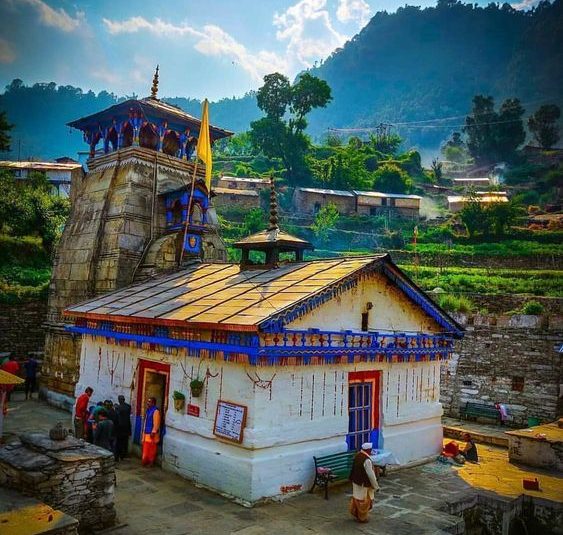Triyuginarayan Temple
Triyuginarayan as Wedding Destination
About
Triyuginarayan Temple

According to Hindu dharma, goddess Parvati was the daughter of Himavat or Himavan, the personification of the Himalayas. She was the rebirth of Sati, the first wife of Shiva, who sacrificed her life when her father insulted Shiva. Parvati initially tried to allure Shiva by her beauty but failed. Finally she won Shiva by practising rigorous penance at Gauri Kund, which is 5 kilometres away from Triyuginarayan. Pilgrims visiting Triyuginaryan temple also visit the Gauri Kund temple dedicated to Parvati, which is the base camp for trek to Kedarnath Temple. Mythology states that Shiva proposed to Parvati at Guptakashi before they got married in the small Triyuginarayan village at the confluence of Mandakini and SoneGanga rivers.
Triyuginarayan is believed to be the capital of Himavat. It was the venue of the celestial marriage of Shiva and Parvati during the Satya Yuga, witnessed in the presence of the holy fire that still burns eternally in front of the temple in a Havanakund or Agnikund, a fourcornered fireplace on the ground. Vishnu formalised the wedding and acted as Parvati’s brother in the ceremonies, while the creatorgod Brahma acted as the priest of the wedding that was witnessed by all the sages of the times. The exact location of the wedding is marked by a stone called Brahma Shila in front of the temple. The greatness of this place is also recorded in a sthalapurana, a scripture specific to a pilgrimage centre. According to the scripture, pilgrims who visit this temple consider the ashes from the burning fire as holy and carry it with them. It is also believed that ashes from this fire are supposed to promote conjugal bliss. Before the marriage ceremony, there were no people who witnessed the incident; the gods are believed to have taken bath in four kunds or small ponds, namely Rudrakund, Vishnukund and Brahmakund. The inflow into the three kunds is from the Saraswatikund, which, according to legend, originated from Vishnu’s navel. Hence the water of these kunds is considered to cure infertility. The ashes from Havanakund are supposed to promote conjugal bliss.
The Triyuginarayan temple is similar in architectural style to the Kedarnath temple and therefore attracts many devotees. The present shrine is also called the Akhand Dhuni temple. It is believed to have been built by Adi Shankaracharya. Adi Shankaracharya is credited with building many temples in the Uttarakhand region. The shrine houses a silver 2-foot image of god Vishnu Narayana accompanied by his consort, the goddess of wealth Lakshmi, and the goddess of music and learning Saraswati.
The havanakund with the eternal flame, which is the witness of the wedding of Shiva and Parvati, is situated in front of the temple. Devotees add samidha sacrificial offerings of wood to the flame and collect the ashes as blessings. A stone called the Brahma Shila, which is in front of the temple, is regarded as the exact spot of the divine marriage. A water stream called Saraswati Ganga originates in the courtyard of the temple. It fills all the holy ponds in the vicinity. The ponds of Rudra Kund, Vishnu Kund, Brahma Kund, and Saraswati Kund are holy spots situated near the temple. Rudra Kund is for bathing, Vishnu for cleansing, Brahma for sipping, and Saraswati for offering libations.
The Triyuginarayan Temple is located at an altitude of 1980 metres (6500 ft) about 5 kilometres (31 mi) away from Sonprayag, the confluence of the Mandakini and Songanga rivers.6 The geographical belt is 5 kilometres (31 mi) away from Sonprayag that extends to 14 kilometres (87 mi) between Triyugninarayan and Toshi villages with an average altitude of 2200 metres (7200 ft) that has favourable agroclimatic conditions for growing horticultural crops such as apple and stone fruits. During the three winter months, the area is covered by snow.
How to Reach : Access to the Triyuginarayan village where the temple is located is about 12 kilometres 75 mi from Sonprayag. There exist a few trek routes too like a short trek of 5 kilometres 31 mi via Sonprayag on the Ghuttur Kedarnath bridle path that passes through thick forest area is involved to reach the temple precincts. From Kedarnath which is to the north of this temple, the total trekking distance is about 25 kilometres 16 mi. Ghuttur is around 12 kilometres 75 mi from Sonprayag which is connected by road with Haridwar and other important hill stations of the Garhwal and Kumaon Hills. The nearest airport is Dehra Dun 244 kilometres 152 mi from Triyuginarayan but it is better to start the journey from Delhi. Rishikesh is the nearest railway station 261 kilometres 162 mi from the site.
The Triyuninarayan temple is also accessed by trekking. A popular trekking or excursion route followed is from Mussoorie. The trek route followed from Mussorie which involves 17 days of trekking passes through Tehri Mala road point Belak BudakedarGhuttuPanwali Kanta Triyuginarayan and Kedarnath in that order.1213 Apart from this trekking route, the Department of Tourism Government of Uttarakhand to encourage tourism has identified and developed six major circuits which includes the RudraprayagKedarnath circuit covering temples at Rudraprayag Tungnath Okhimath Madhyamaheshwar Guptkashi Triyuginarayan and Kedarnath along the Mandakini River valley. This circuit involves a total trekking of 69 kilometres 43 mi in addition to road journey.